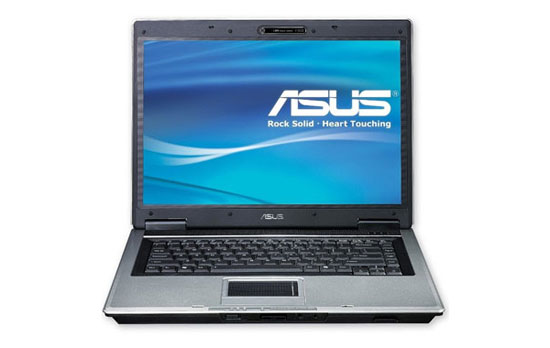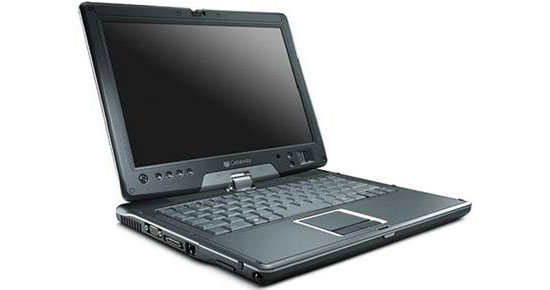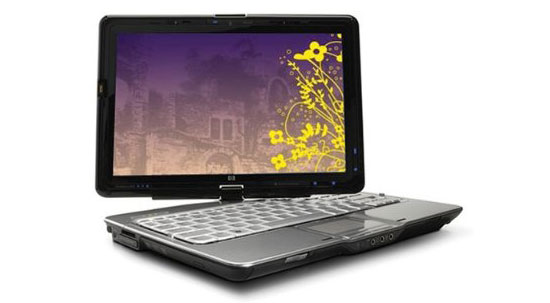Entry-Level Laptops
Entry-level laptops have a lot in common with the budget offerings, and it's basically a story of "more, more, more". You can get somewhat faster processors, more memory, larger hard drives, perhaps discrete graphics, a larger battery, and/or higher LCD resolution. You can also get less if you'd like - as in, less weight and a smaller 12.1" chassis. Sure, the subnotebooks like the Eee PC 901 are smaller, but below around 11.1" keyboard size can become a real concern and you usually get stuck with a lower LCD resolution (1024x600 or 800x480). All of this naturally comes with a higher price, but outside of graphics performance you can easily find a laptop for around $1000 that can handle just about any application. We'll look again at the major vendors to see what options are available in this price bracket.
Upgraded models on many of the budget laptops from Dell, HP, Gateway, etc. fall into the $1000 price bracket. As an example, the Gateway M Series starts at $600 with a Core 2 T5550, 2GB RAM, 160GB HDD, and 802.11G WiFi. The $1000 model bumps the CPU to a T8300 (Penryn), memory to 3GB, 250GB HDD, 802.11N WiFi, and they add in an ATI Radeon Mobility HD 2600. Dell's Inspiron 1420 and 1525 make a comeback, but with a lot more options available. If you want the 1420 and you try to keep the price close to $1000, you have a few options: upgrade the CPU to a T8300; install a Blu-ray drive; or perhaps go with a GeForce 8400M GS and 802.11N WiFi. Other combinations are possible, so what it really comes down to is choice.

If you like large notebooks, there are 17" models available that pack a lot of punch. At the low end of the price spectrum, Gateway currently has their 17" P-172X on sale for $750. This is basically the integrated graphics version of the P-6831 FX that received our Gold Editors' Choice award, only with a smaller battery and a few other minor changes. Virtually every vendor has a similar 17" chassis in the $800 to $1100 price range, and while they may be more expensive than the Gateway you can customize your component selection. If you're not willing to spend more money and you're not concerned with gaming performance, we'd suggest trying to find a 17" LCD with a 1680x1050 resolution. 1920x1200 is usually only a midrange or higher option, but you can find it in some reasonably equipped AMD Turion X2 options, like MSI's MS-171A that you can customize at vendors like AVADirect; $1000 for 1920x1200 and 2x2GB RAM with Mobility HD 2600 may just be enough to sway some users away from the Intel camp.

15.4" models are the most common notebook chassis it seems, but our one major complaint is that many come with low quality 1280x800 LCDs. There's a reason most of the $500 budget notebooks are 15.4" designs, so if you're willing to spend more money we would look more at the 17" or 14" options. There are 15.4" notebooks with higher resolution displays that are worth a look, however. Looking at Newegg, the ASUS F3SV-B3 has a 1440x900 panel, 2GB RAM, T7500 CPU, GeForce 8600M GS, and plenty of other features for just under $1000. Also at Newegg, the HP 6715b ups the ante to 1680x1050 and ships with Vista Business, but cuts back in other areas - the Turion X2 TL-60 CPU, 1GB RAM, and Radeon X1250 integrated graphics being the most noteworthy. However, you might consider other HP business options that come with a 3-year warranty if you purchase direct from their site. AVADirect sells a Compal FL92 notebook that you can get with a WSXGA+ LCD, 2GB RAM, 160GB HDD, T8100 CPU, 8600M GT, 802.11N WiFi, and a 9-cell battery for around $1100. If you don't mind the 1280x800 LCD, Gateway's M-152XL has a great feature set for only $1050 (with the current $250 instant rebate), or grab the Best Buy version M-6850 FX for $1000.

For the 13" to 14" laptops, we're again stuck with a lot of lower quality 1280x800 LCDs, which we'd just as soon avoid. It's not the end of the world, but you might want to try the laptop out in person before making a decision as some of these displays are really lousy. Ideally, we'd like LED backlighting as a minimum, but that's usually reserved for more expensive options. The Dell Inspiron 1420 remains our pick of the 14.1" $1000 notebook offerings; there may be something better out there, but we were unable to find it. The base Apple MacBook also falls into this category, priced at around $1100; given the 1GB RAM and stripped down features, however, we'd hold off on a MacBook until the midrange offerings. Somewhat surprising is that there's even a couple tablet options from Gateway starting at around $1000: the C-141X and C-142XL. The latter is amazingly well equipped for a starting price of $1100: T8300, 3GB RAM, 250GB HDD, 8-cell battery, DVDR, and a Radeon Mobility HD 2300.

The final option for the $1000 price range is a few 12.1" thin and light offerings. Most of these models fall into the midrange and higher price brackets, but there are a few affordable laptops. Newegg has the ASUS F9E-A1 $1050 (with the current $50 sale). That will get you a T5550, 2GB RAM, 160GB HDD, X3100 graphics, 6-cell battery, and a 2-year warranty. The Lenovo 3000 V200 has similar specs for about the same price (once you upgrade the warranty). HP Home has the Pavilion tx2500z tablet PC starting at $950, and the preconfigured tx2510us will set you back $1075 with a very attractive feature set: Turion X2 ZM-80 (2.1GHz), 3GB RAM, 250GB HDD, DVDR, 802.11N + Bluetooth, and integrated HD 3200 graphics. Other vendors have competing models, but we'd steer clear of the 1GB laptops when you're spending any more than $750. It's possible as always to upgrade the RAM on your own, but particularly with smaller designs this can sometimes require a decent amount of effort.
To summarize the entry-level notebook market, there are a lot more options out there than we can even begin to cover. What you need to determine is where you'd like to focus your money. You can get better display options, faster CPUs, a smaller chassis, better battery life, moderately powerful discrete graphics, more memory, larger hard drives, a longer warranty… but you can't get all of these things in any single notebook without spending more money. At best, you can pick about three or four of those areas to upgrade relative to the budget notebooks. That said, there are some really good notebooks priced at $1000 or less these days. They aren't the fastest laptops on the planet, but some of these laptops can handle everything up to and including moderate gaming. For example, if you want a mobile World of Warcraft platform, you don't need anything more than an HD 2600 or GeForce 8600M.










28 Comments
View All Comments
theoflow - Wednesday, August 20, 2008 - link
I know this is pretty much covered in the first line of this article, but I'm dying to see the new desktop system build guides.I've been out of system building for about 3 years and I'm somewhat clueless as to what direction I should go.
ARG!!!
LOL
Rekonn - Sunday, July 27, 2008 - link
"we understand the P-6860 is scheduled to be replaced in the future by another slightly upgraded model"Anybody know details on this?
JarredWalton - Sunday, July 27, 2008 - link
Yes but it's under NDA. I can tell you next month, and trust me you'll be impressed (again).Rekonn - Tuesday, July 29, 2008 - link
Sweet, looking forward to it.Rekonn - Monday, August 4, 2008 - link
Think I found it, the Gateway P-7811 FX. Available on August 14th for $1500.http://laptopcom.blogspot.com/2008/08/gateway-p-78...">http://laptopcom.blogspot.com/2008/08/g...y-p-7811...
Now, how much better is a 9800GTS vs an 8800 GTS?
JonnyDough - Saturday, July 12, 2008 - link
I have a hard time with believing that the "mid-ranged" notebooks are between $1500 and $1750. It's like you pulled these numbers out of thin air and you neglected the $1K-1.5K segment altogether. $1K is where a decent modern laptop starts. Anything pushing $1500 is too much for many people to bother spending, while $1K is about right. I just got a Dell flier, the multi-page one with desktops in it too. The majority or main line notebooks start at $999, like the Inspiron. Granted, you can add options for a hundred here or there, but the starting price is $999 on a few different lines of their notebooks. I would have to say that this is the "mid-range" as they show a $999er right on the front page. You can shop NewEgg and find decent laptops that are older processors and so on for $500ish. So saying that $1500-$1750 is "mid-range" is complete bullocks. Mid-range is the budget minded market segment that wants something just a bit better than the bare minimum and it's what Dell caters to and always has. The mass market. Mid-range = mass market. Period. There's no argument against it. Budget does not = mass market. Budget = budget = those that have to watch every dollar. Remember mainstream America? Remember those that pinch pennies but still go to the fair? Yeah, us. The middle income folks. The majority of America does not live in poverty, yet. Thanks.JonnyDough - Saturday, July 12, 2008 - link
Eek! They edited the article right after I posted. LOLJarredWalton - Sunday, July 13, 2008 - link
Um... no, we didn't. I had budget, then Entry-level, then Midrange, then High-end, then Dream since the beginning. As I mention in the intro, the price brackets are indeed somewhat arbitrary with plenty of overlap. I may call $1000 "entry" and $1500 "midrange", but regardless of the name I did my best to cover all bases from $300 up through $5000. As I mention on the Entry-Level page, $1000 will get you a LOT of laptop, and unless you want gaming (i.e. Gateway P-6860) a lot of people can stop right there - give or take $250.Jjoshua2 - Saturday, July 12, 2008 - link
I think the 6-cell Wind is pretty cool. I pre-ordered one from buy.com and I was able to use a coupon that got me $15 off. Now I just hope it will get in-stock soon.fabarati - Saturday, July 12, 2008 - link
Besides warranties, this article lacked Two major points that are often overlooked - and one not quite as oftenly overlooked -when shopping for laptops: Build, Screen and Battery.Build quality is very different from laptop to laptop. Generally business lines are better built than consumer lines, which are better build than budget lines. There are laptops that are built better than consumer laptops, but worse than business ones, etc. That's why a same specced Thinkpad T61 is more expensive than a HP DV6700 (typical consumer build quality) or any acer (crappy budget build). Or why a an XPS m1530 is a better buy than an Asus M50/51
Screen is also overlooked. Nearly all laptop screens are horrible compared to desktops. They're all TN screens. The very, very best are at about desktop mid-range TN's level.
Batterylife depends on more than just what specifications a computer and the battery has. It also depends on ACPI and bios coding, and what and how good the batterysaving applications that come with are. Almost ny new Asus (Santa Rosa or newer), with a few exceptions like the U2e, has horrible batterylife. Some have a hard time reaching 2 hours under normal usage.
Then there are some small stuff that nagged me about this article, mainly performance things. Whilst the HD3650/9500m GS/8600m GT/HD2600 are not really powerful, even when not compared to desktop midrange alternatives, they are possible to game on. In fact, you'll get a pretty decent gaming experience, and it'll be portable. They are just usually run on lower resolutions (because many laptops they're in have lower resolutions) and lower (medium) settings. The fact that they can't run a game on all high does not make it un-gameable.
Anywho, you guys didn't do too many mistakes, and had some Ok recomendations. Pretty good for beginners.